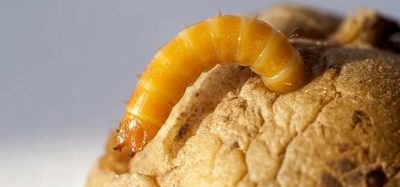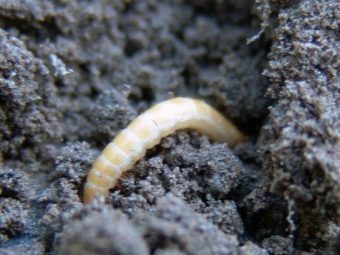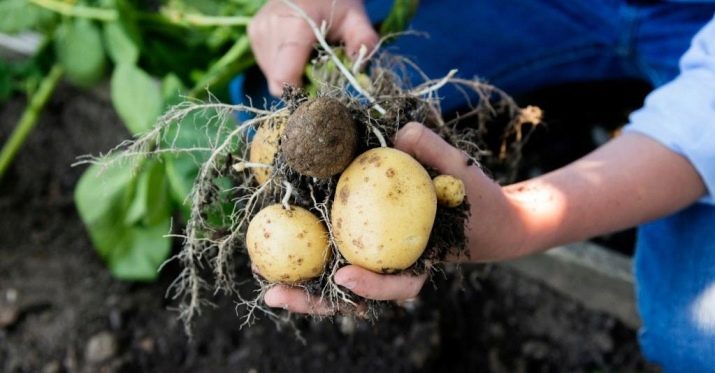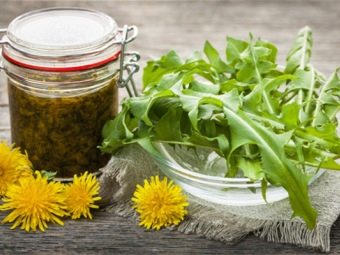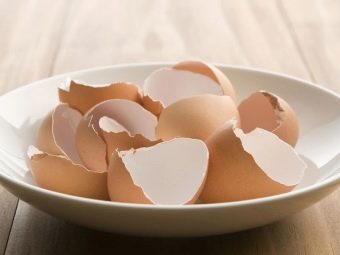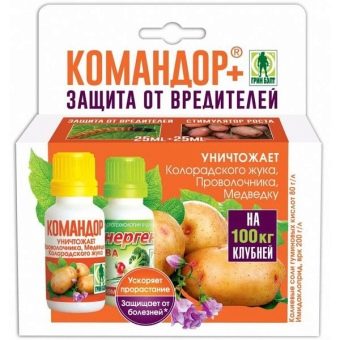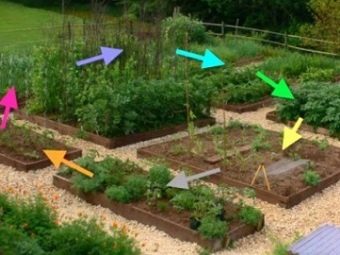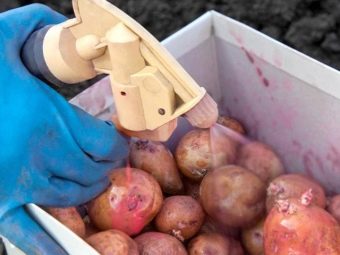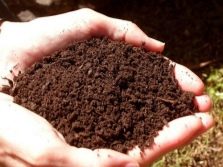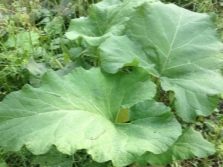How to process potatoes from the wireworm before planting?
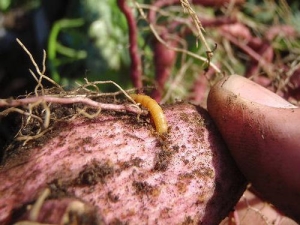
Wireworm is called one of the most dangerous pests that affects potato tubers. For a long time, the attention of gardeners was exclusively devoted to the extermination of the Colorado beetles, while not so much was known about the wireworm, and the available knowledge is rather superficial. Despite this, the damage caused by the wireworm to potatoes can be much stronger, and the fact that the tubers are deep in the soil makes the destruction of the wireworm extremely difficult. However, processes such as pest control and protection of potato tubers must be carried out.
Let us consider in more detail the problem of controlling the wireworm, as well as what preventive measures can be applied so that this pest never appears on your site.
About wireworm and its harm
The wireworm is not an adult. By and large, it is a larva of such an insect as a click beetle. The latter is a fairly harmless creature that feeds exclusively on the leaves of the cereal plants, while not leaving behind the unpleasant consequences for the gardener. Its size is insignificant, the body is slightly oblong, two centimeters long. The color of an adult individual varies from dark brown to deep purple. You can notice their appearance on the garden plot at the beginning of the spring period and at the end of the summer. During the summer, the female click beetle produces about two hundred eggs. After a short period of time, the larvae hatch from the egg, which is called the wireworm. This pest is called so because of the hard shiny back, visually reminiscent of wire.
Larvae are famous for their gluttony. Adults are completely harmless to the crop, while their offspring brings gardeners one headache. Before the larva turns into an adult beetle, it is under the ground for about five years. During this time, the wireman makes a lot of deep ornate tunnels, while he devours everything he comes across. Just hatched wire is almost harmless. He has a small calf, and therefore has no need for a large volume of food. But the larva, whose age has reached two years, begins to pose a great danger to potato tubers under the ground.
Her body with a clearly segmented back reaches two to three centimeters. In addition to the length, there is a change in the color that darkens, turning from light yellow to brown. It is also worth noting that the age of the wireworm affects the hardness of its body. The older the worm, the harder it is to crush.
Wireworms, whose age is more than three years, are almost impossible to crush. The most effective way to get rid of it would be to split it in half with a knife or spade.
In addition to the voracity of the wireworm is peculiar omnivorous. The priority for them is nutrition, and what exactly is not so important. In most cases, potato tubers are affected, but carrots, tomatoes, cabbage, beets, rye and many other crops also fall from wireworms.
It does not matter whether it is planted seeds, root system, shoots or stems. Thanks to the voracity and omnivorousness of this pest, the average grower loses sixty-five to eighty percent of the crop each year. Worms adapt well to life underground in winter, and when spring comes, they reap young seedlings with new vigor.
Pest Presence on Potatoes
Tubers for wireworm - a real treat, but they do not disdain and eating the entire root system, and even the tops. It is not so easy to notice the pest at sowing. But there are signs to determine the presence of a worm and quickly take steps to eliminate it.
- Separate wilted potato bushes. This is due to the fact that the wirewound, being underground, is restricted in movement and can move exclusively along the vertical axis, making indentations in the soil one to two meters. At the same time, he does not crawl more than twenty centimeters from his “trough”. Due to its peculiarity, the wireworm is able to devour a predominantly separate part from the whole plant.
- Young potato tuber possesses through narrow apertures with the help of which the worms make their movements, and dark spots on the outer surface. Often it can be detected by digging up potatoes early.
- Mark the presence of wire worms when digging or loosening the beds with potatoes. In the summer, worms move mainly along the top layer of soil (five to ten centimeters).
Visually, the larvae of the click beetle can be confused with ground beetles, who bring enormous benefits to the potato, helping the gardener to exterminate pests. Explorer has one feature - if you turn it over, you can hear a click.
Folk recipes that relieve the wireworm
If the confrontation with the larvae occurs in a potato field, then it is advisable to use folk methods rather than ready-made chemical preparations. Since the latter tend to be absorbed into potato tubers, which negatively affects the quality of the crop. In extreme cases, give preference to products made from organic matter. The most effective and safe method for a gardener will be the processing of potatoes before planting them in the ground.
The most affordable and affordable remedy for wireworm is an egg shell. It is crushed and put into each well immediately before planting potatoes or evenly placed over the entire area of potato beds. An alternative to the shell can be onion and garlic husks.
Tincture obtained from dandelions or nettle is very effective in fighting the wireworm larvae. To prepare, you need five hundred grams of nettle (or two hundred grams of dandelion) infusion mixed with ten liters of water. After which a small amount of the resulting solution is poured into each well seven days before the intended planting of potatoes with an interval of three days.
Ammonia present in the composition of ammonium nitrate (or ammonium sulfate) perfectly copes with the task of destroying the larvae of the beetle click. Processing this solution causes the larvae to hide deep in the ground, where they remain without food and subsequently die. One square meter should be processed twenty to thirty grams of solution.
Potassium permanganate is an alternative to ammonium nitrate, which has a similar effect on wire larvae. Processing is carried out before planting potatoes. It is also acceptable to handle adult bushes. Ten liters of water should be no more than two to four grams of potassium permanganate.
Chemistry against wireworm
The use of a chemical drug is permissible only when planting potatoes, mid-season or late ripening. Early potato variety is not able to get rid of the chemistry absorbed in the tubers. The most well-known chemicals in the fight against wireworms are "Commander", "Taboo" and "Prestige".
The extermination of pests with the help of preparations made on a chemical basis, is carried out exclusively in accordance with the instructions and with the use of personal protective equipment.
The most commonly encountered drugs for the destruction of wireworms in potato fields are homemade solutions. In order to prepare such, it will take five kilograms of granular superphosphate, which must be evenly decomposed on film. Next, you need a solution to process it.Depending on your preferences, you can choose such solutions as “Decis”, “Karate” (with dosage up to one milliliter), “Actellic” (with dosage up to fifteen milliliters), “Fastak” (with dosage up to two milliliters).
One of the selected solutions is mixed in an acetone solution, which is obtained by mixing two hundred milliliters of acetone with eight hundred milliliters of water. The resulting solution is sprayed around the perimeter of the decomposed superphosphate. As soon as it dries, it is necessary to decompose it in potato beds. The calculated amount can cover up to one hundred square meters.
Preventive measures
The fight against the wireworm is in many ways similar to the fight against other harmful insects - it is much easier to prevent the hatching of the larvae than to try to exterminate them after. So, preventive measures to eradicate wireworms are characterized by several agrotechnical measures that will contribute to the treatment of the soil:
- First of all, it is necessary to adjust the crop rotation, that is, the sequential alternation of vegetable seeds in a garden or a vegetable garden. This allows the soil to not be covered with weeds, and therefore the pathogens and pests do not survive. However, most gardeners and gardeners ignore this process. It should be noted that crop rotation significantly improves the quality of the crop.
- In the autumn, it is necessary to carefully collect all the roots and other plants. A well-cleaned garden area will not be able to feed the larvae in the winter, and therefore many of them will die.
- In the fight against wireworms, you can attract birds (starling, wagtail or rook) and insect allies (ground beetles) that will eat click beetles and their larvae. In order to lure the birds on your site, set the birdhouses.
- By destroying weeds such as burdock and wheatgrass, you are fifty percent closer to completely eliminating these pests on your territory.
- In order to prevent the appearance of wireworms, it is necessary to regularly monitor the level of acidity of the soil. This pest prefers acidic soils, the soil with a low level of acidity is an unfavorable environment.
In order to determine the level of acidity of the earth, just walk through your garden plot. If you notice an active growth of field horsetail, plantain and sorrel, then we can conclude that the level of soil acidity in your area is quite high. Therefore, it is necessary to conduct liming.
In the next video, see an effective way to protect potatoes from the wireworm, bear and the Colorado potato beetle.


